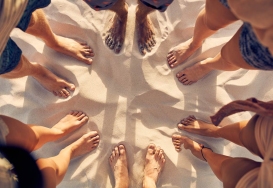Recently the Chicagoland area has had very sporadic wet, rainy, and, snowy weather mixed with mild temps just above freezing. This type of inconsistent weather brings the dangers of black ice. Although spring is around the corner, we still need to be mindful of the snowy mix of weather that causes black ice.
What is black ice? Black ice, also known as glaze ice or clear ice, is a transparent thin layer of ice that develops after sleet or light rain falls or snow melts on the ground which still maintains a temperature between 0 degrees and 32 degrees Fahrenheit. This type of ice is very dangerous because it takes on the same color as the pavement and is virtually invisible.
Every year approximately 1 million people in the U.S. have ice related falls of those 17,000 can be fatal. 50,000 workplace injuries involve ice or snow, of those reported 8% actually occur indoors from wet floors.
The majority of these injuries affect the lower extremities such as ankle and foot strains, sprains and fractures. Other serious injuries may occur such as head trauma, rotator cuff tears, wrist fractures (collies Fractures), knee and hip injuries (ACL Tears, Patellar Fracture and Hip Fractures). No matter what type of injury, all can lead to days off of work, need for surgery, long term debilitation, or even death.
What can put you more at risk for slipping on black ice:
- Shoes with rubber soles, flat soles without treads
- Running on the pavement or rushing around
- Not paying attention
- Lack of deicers on the pavement
- Lack of floor mats and runners in doorways
- Carrying things in your arms
- Uneven pavement
- Age (People the age of 50-60 years of age have more falls than older individuals. The Journal of Allied Health) This population are more at risk for serious brain injury according to the CDC.
Part of preventing serious injury is learning how to fall properly:
If you know you are going to fall, the best thing you can do is get closer to the ground. Think about it — falling from six feet off the ground will be more painful than falling from two feet off the ground. So bend your knees. It'll instantly reduce the distance of your fall.
- Stay loose
- Protect your head
- Bend your arms and legs
- Turn as you fall
- Roll out of the fall if possible
- Try to fall on the meaty parts of your body
- Try to spread out the force of the fall
- How to Properly Fall according to AARP.
Prevention of Falls On Ice:
- Wear proper footwear for the weather
- Make sure all surfaces and walkways are properly cleared of ice and snow
- Apply ample amounts of deicer, salt, or sand to walkways
- Take smaller steps, avoid running
- hold on to railings when going down steps
- Pay attention to your surroundings
- Apply runners and mats in doorways that absorb moisture and are slip resistant
- Elderly people should take their time and ask for assistance if needed. They should hold on to someone if possible
A good tip is to keep your cell phone in your pocket so if you fall and injure yourself, you can access your phone and call 911. Remember if you are on blood thinners or aspirin this can cause internal bleeding. If you hit your head it is recommended to seek medical care in the first 24 hours of the injury.
If you injure yourself, it is always advised to seek medical care. IBJI’s OrthoAccess immediate care clinics are a great resource for injured patients. If you fall, you can walk right in to OrthoAccess without an appointment to assess your injuries.
Obviously not every fall can be prevented, but if you follow these simple recommendations you can survive the end of winter and make it into spring, fall-free.
Douglas Solway, DPM, is a podiatric physician who specializes in the treatment of many conditions of the foot and ankle. He performs surgery of the foot and ankle, treats injuries for sports medicine and offers regenerative therapy.
*This content is for information only and is not intended to replace the diagnosis, treatment, or medical advice from your treating healthcare professionals. The content does not provide medical advice, does not constitute the practice of medicine or other healthcare professional services, and does not create a doctor-patient relationship. You should not rely on this information as a substitute, nor does it replace professional medical advice, diagnosis, or treatment. If you have concerns or questions, seek the advice of your healthcare professionals. If you think you may have a medical emergency, call your doctor or 911 immediately. Do not rely on electronic communications or communicate through this website for immediate, urgent medical needs. This website is not designed to facilitate medical emergencies. The use of the information is at the reader’s own risk. The links are provided for information and convenience only. We cannot accept responsibility for the sites linked or the information found here. A link does not imply an endorsement of a site.




